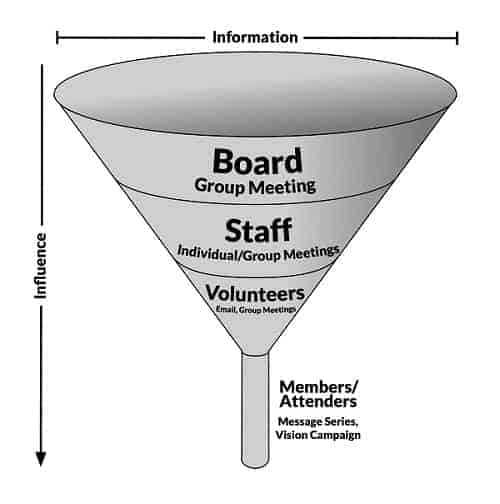
As we’ve already covered in this series, over-programming is one big reason why churches feel stuck. It is also one big reason why churches struggle with communications. You have to bring your vision and strategies into focus before you can focus your communication.
Tony gave some really practical advice a few weeks ago about how to decide what programs you need to cut. Once you make those hard decisions, the real communication work begins.
Last year I had the privilege to serve with Kem Meyer and some other talented communications directors to coach nine churches of all different sizes, denominations and strategies on communications strategies. Each church had self-diagnosed communications as a major issue. They were all in the middle of leading significant change, many of them as a result of strategic planning with The Unstuck Group.
Through that experience, we compiled some top tips for communicating change. As you begin eliminating complexity in your church, you may want to refresh yourself on these regularly:
-
Relationships Matter.
The relationships inside any transition are the hardest to protect. When you bear down and focus on the task alone, people get hurt. Don’t skip the crucial “soft side” steps in your plan.
-
Think Through People Groups.
Think through how the change affects the ONE, the FEW and the MANY. The talking points aren’t the same for every people group. Consider sequencing and timing.
– More lead time for people who the change could damage/impact for good or bad.
– Less lead time for people who just need the basics.
– Plan around key events that help people make sense of and rally around the change. -
Think of the Pathway.
The volume of the channel should match the impact of the change. In other words, not everything is a stage announcement. Sometimes it’s just a conversation with a small group of people.
Here’s a visual illustrating this point that we share with The Unstuck Group clients when they are planning communications:
-
Test Drive.
Ask questions with a test audience to identify what’s not clear before rolling out to the wider audience. Choose words carefully. Develop nomenclature for the change. A simple “how we say what” tip sheet is helpful for stakeholders. For example, “invite vs. recruit” or “private 24/7 hub” vs “social network” and “check-in upgrade” vs “database implementation” are examples of different word choices that trigger different reactions for different audiences.
-
Remember the WHY.
Connect all change to the WHY. The WHY is the main deal; the what supports it. Not the other way around. Communicate this appropriately and personally to every group.
-
Boil the Frog; Don’t Stir-Fry.
Give people time to process the change. Not everyone will embrace the change right away. Give them an appropriate forum to ask questions, share concerns (could be a meeting or an online feedback form).
-
Get the Right People at the Table Up Front.
Make sure you’re processing the full picture by having all perspectives for input in the room before you make the change. There are always buried landmines you will uncover in these meetings.
-
The “Who” Is More Important Than the What.
Even though the change may be for the benefit of a common audience or goal, they may not feel it at first. Be sure to remember who is feeling the impact of the change and be sensitive to the impact. Plan time for turbulence and redirects, if necessary.
-
Honesty Is More Important Than Brilliance.
People are smart. Treat them like it. Be real. Embrace humility along with confidence.
-
Get Input from Many, Decisions from Few.
Consensus is not a value for most change. Just giving people a chance to be heard goes a long way to creating buy-in, even if they don’t get their way.
Most church leaders understand when communication is breaking down, but they don’t often understand the real reason why.
In most cases, communications chaos is a symptom, not the problem in and of itself. You can’t communicate an unclear vision, competing priorities or fuzzy strategies. If you need help with that, learn more about how The Unstuck Group serves churches like yours.








Leave a Reply